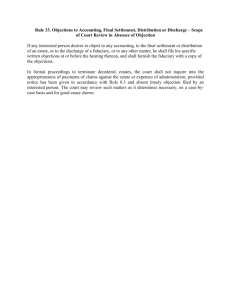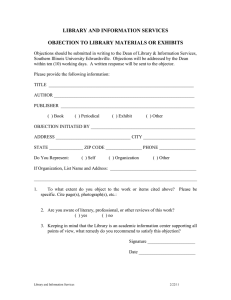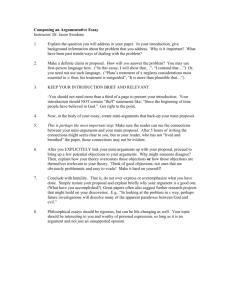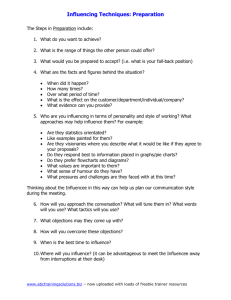The Sales Process Steps 4 and 5 Chapter 14.1 & 14.2
advertisement
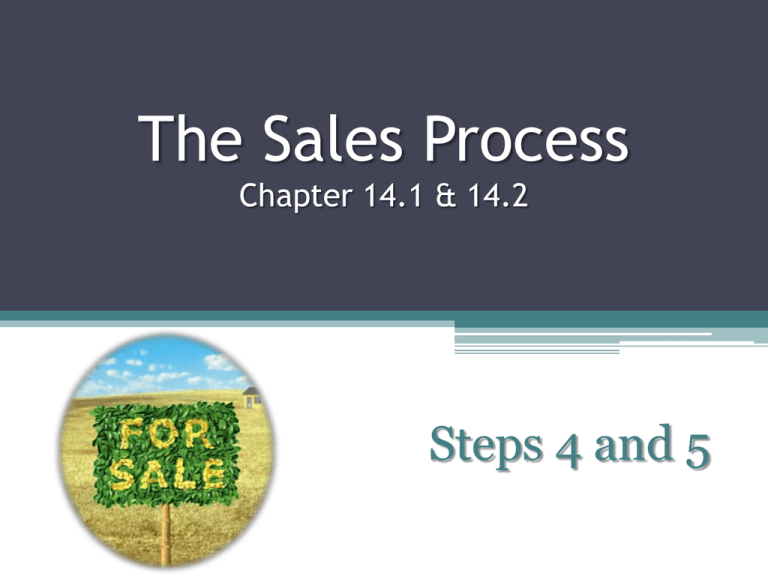
The Sales Process Chapter 14.1 & 14.2 Chapter 14.1 and 14.2 Steps 4 and 5 Step Four: Presenting the Product • The step of the sales processes where you can share your expertise with the customer Which product do you show? – after the approach stage you should have learned enough about the customer to determine which products will best meet their needs For a customer who wants a camera for professional use For an inexperienced customer who is looking for their first digital camera Step Four: Presenting the Product What price range should you offer? • If you have not determined the customers price range, you should start your presentation with a mid priced item • Don’t introduce price right away unless it is a major selling point – you need to show them the value in the product first ▫ If you present the product and they decided they must have it, price becomes less important Step Four: Presenting the Product How many products should you show? • To avoid overwhelming the customer never show more than 3 options • It is difficult to remember the features of more than 3 products • If the customer wants to see more, eliminate one before adding another Tips for Effective Product Presentation Display and Handle the Product • How the product appears to the customer is important • Always handle the product with respect and care Tips for Effective Product Presentation Demonstrate • Show the customer how the product works • Show the product in use Tips for Effective Product Presentation Involve the Customer • Let the customer try (experience) the product • Give away free samples • Encourage the use of one or more of the five senses • Car sales – test drive What do you say? • Talk about the product’s features and benefits • Use descriptive adjectives • Avoid unclear words like fine, nice, pretty • Avoid slang and words with double meaning • Use Layman’s Terms: words the average person understands Use Sales Aids • • • • • • • • • • Samples Reprints of articles Audio-visual aids Models Photographs Drawings Charts Specification sheets Customer testimonials Warranty information Step Five: Objections • Objections: concerns, doubts, hesitations or other reasons a customer has for not making a purchase • Should be viewed as a positive because they allow you a chance to present more product information • Being prepared for objections will help you feel more confident Step Five: Objections • They can come in the form of a question or a statement ▫ “Do you have any other products to choose from?” ▫ “These shoes are not the right color.” • Excuses: reasons for not buying a product ▫ Often used when a customer is not in the mood to buy or are hiding their objections Objections vs. Excuses Objections Excuses • “I don’t really need another coat.” • “I’m just looking.” • “I can’t wear this dress to work.” • “I‘ll have to talk to my wife about purchasing it.” • “This is much too expensive.” • “I didn’t bring my money with me today.” Common Objections Most objections fall into four categories ▫ Need usually occurs when the customer doesn’t have an immediate need for the product or they want the product but they don’t need it “I want these sandals but I don’t need another pair.” ▫ Product Objections based on the product itself (more common) Concerns about construction, ease of use, quality, color, size or style “I don’t like 100% cotton shirts because you have to iron them.” Common Objections ▫ Source Objections based on source often occur because of negative past experiences with the company or brand Happens most often in business to business sales “The last time I ordered from your company, I received it two weeks after the promised date.” ▫ Price Objections based on the cost of the product “That is more than I wanted to spend.” Four-Steps for Handling Objections • Listen Carefully – be attentive, make eye-contact, let customer talk • Acknowledge the objection – demonstrates that you understand and care about their concerns ▫ “I see your point.” ▫ “Others have asked the same question.” • Restate the objection – to ensure you understand their objection ▫ Don’t restate word for word - paraphrase • Answer the objection – try and find a solution 7 Methods for Handling Objections 1. Substitution – recommending a different product that would better suit the customer’s needs 2. Boomerang – bring the objection back to the customer Customer: “These gloves are so lightweight. They can’t possibly keep me warm.” Salesperson: “ The gloves are so light because of an insulation material called Thinsulate. The manufacturer guarantees that it will keep you warmer than fiberfill insulation, without the bulk and extra weight.” 7 Methods for Handling Objections 3. Question – ask the customer more questions to learn more about their objection 4. Superior Point – acknowledge objections as valid yet offset them with product features and benefits 5. Denial – use when customer’s objection is based on misinformation ▫ Be prepared to provide proof to back you up 7 Methods for Handling Objections 6. Demonstration – show the customer how it works Seeing is believing 7. Third party – using previous customer’s or another neutral party who gave testimonial about the product Infomercials • Good Morning America Infomercial • Testing Infomercials Hawaii Chair Shake Weight Tiddy Bear Snuggie Shamwow Slap Chop Assignment Chapter 14 Bookwork 14.1 – pg. 300 – Key Terms and Concepts…..(1-3) 14.2 – pg. 307 – Key Terms and Concepts…..(1-3) Chapter Review – Review Facts and Ideas…..(2-11) You will be held responsible for all the red dot terms for the test

